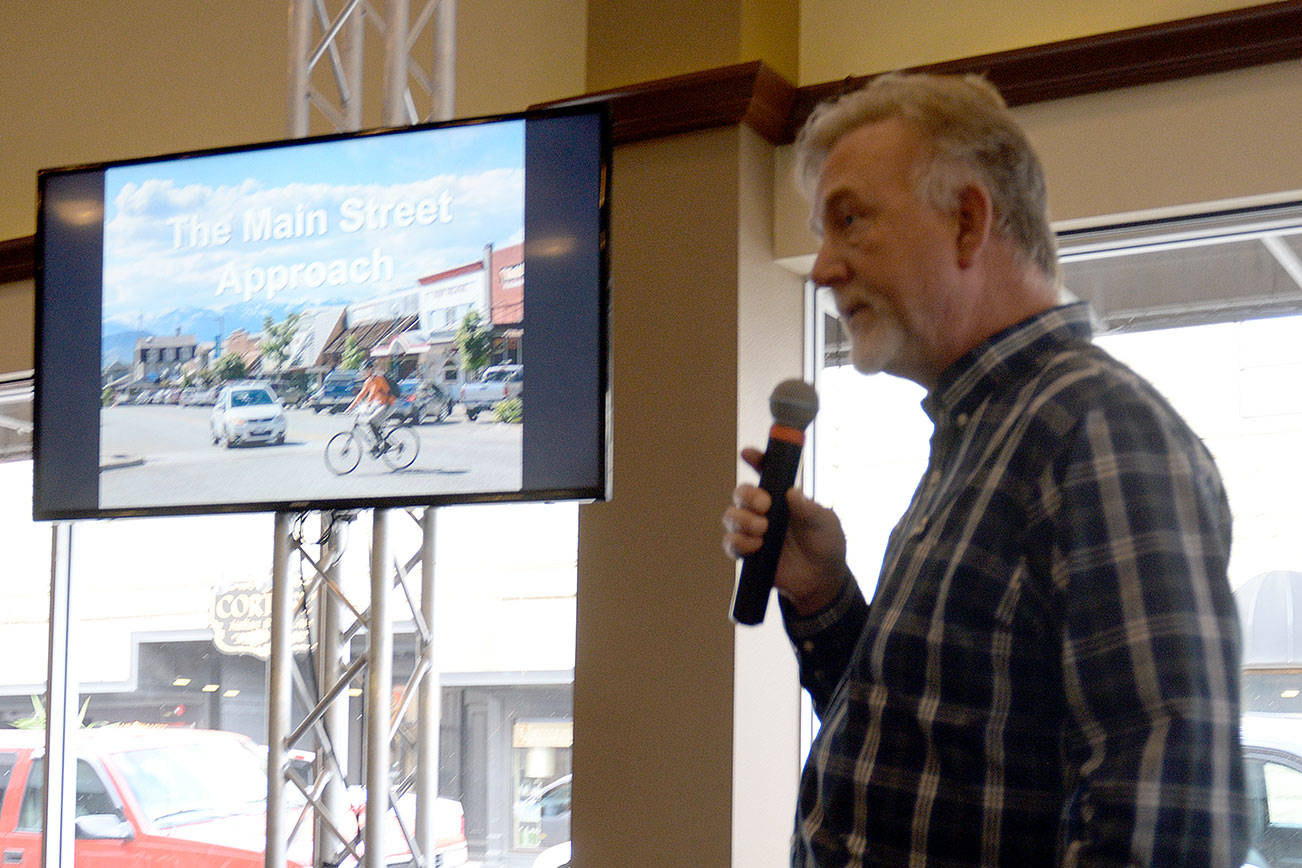Main Street, a program that aims to bring back decayed downtown business districts in small cities, could work in Aberdeen and provide the resources to completely revitalize downtown, supporters said Tuesday evening at an open house informational meeting at the D&R Events Center.
Aberdeen Mayor Erik Larson opened the meeting, saying he was proud the city has agreed to partially fund the effort.
“I’m pleased the city is spending some money to help support downtown businesses and the community,” he said.
Before about 50 business owners and community members, Aberdeen Revitalization Movement President Gary Jones, who was part of a successful Main Street effort in Ellensburg, explained the details of a Main Street community. Main Street designation is decided by the state Department of Archaeology and Historic Preservation.
“The Main Street program grew out of the urban renewal movement of the ‘70s,” he said. While that movement, which focused primarily on the removal of slums, had its issues according to Jones, its core basis of rejuvenating urban business areas is the cornerstone of the Main Street movement.
“In the old times, Main Street in any town was where they did all their business,” said Jones. Over time, he said, retailers and other businesses expanded their reach outside of the downtown corridor, and downtown areas across America were abandoned and left to rot.
Jones, who is vice president of commercial banking for Bank of the Pacific in Aberdeen, said the Main Street principal is about self help; the director of the program and its board members serve as a rallying point for downtown businesses and give them a voice in city and state politics, and more importantly, organizes them into a single, cohesive body that can work together to improve not only their own businesses, but others, and the community as a whole.
“This effort is action-oriented,” he said. “We can take a more proactive and focused effort to improve our downtown.”
Jones said one of the first tasks of the Main Street organization will be taking inventory of all the businesses and buildings in downtown Aberdeen. He said there are a number of buildings that are vacant and have fallen into disrepair that could be updated while still maintaining their historical facades.
“We are looking to develop public/private partnerships,” said Jones. “There are manufacturing companies looking for locations that are attractive, that are good places to work, live and play.”
Jones said another key element is finding the owners of downtown property who may not live locally. Discussions with out-of-area owners who have let their properties fall into disrepair and become magnets for vagrants could lead to viable options to revitalize that property.
The Main Street movement requires the hiring of a full-time director, something the City of Aberdeen has agreed to partially. Jones hopes to have a director in place soon. He said he knows it’s a challenge to find the right fit for a Main Street director (“They’re a different breed,” he said.) but he knows qualified candidates are out there and up for the challenge. His plan is to have a director on board in October and submit the initial application for Main Street designation later that month.
Jones and Aberdeen Revitalization Movement board member Bette Worth urged those in attendance to fill out the comment cards left on the tables and to volunteer to become a member of one of the Main Street committees. “You don’t have to be on the board to be in a committee,” said Jones, who added the more diverse the membership the better, a mix of community members, business owners, local officials and property owners.
There are substantial tax breaks involved with the Main Street program as well, said Jones. Any business license holder in Aberdeen would get a Business and Occupation Tax credit of 75 percent of their contribution to the Main Street organization the following year. For example, contribute $1,000 to the movement and you’ll save $750 on taxes the year following your contribution.
Jones has seen what Main Street designation can do. He and others saw the need for it when he was living in Ellensburg and saw the results firsthand. Ellensburg was rapidly wasting away as businesses moved out of the downtown core and into the more accessible property right off of Interstate 90. The group of business owners and community members organized, and the local chamber of commerce got involved. Now, a downtown district that used to have a 50 percent vacancy level is once again thriving, with new businesses coming in to once-abandoned downtown properties.
Jones sees similar opportunities in Aberdeen. He noted existing storefronts in town have second and third floors that are going basically unused – the same thing he saw in Ellensburg. He named as an example the old Elks lodge in Ellensburg. The lodge had moved to another location out of downtown and the building was sold to an owner who did nothing at all with the building. When Main Street organizers there came together they were able to attract a new owner for the building, which Jones said is now home to several new businesses.
Larson, Jones and Greater Grays Harbor CEO Dru Garson addressed questions about Main Street and its impact on the vagrancy issue. Larson emphatically stated that the Main Street program is focused on improving downtown through improving the business climate; it’s not a social services program. But all three noted that improving the look, feel and attitude of downtown Aberdeen will lead to a better downtown for everyone, not just business owners. A more prosperous downtown, they said, will benefit everyone.
Main Street is a long-term commitment that requires full buy-in from downtown businesses and the community, said Jones.
“There’s lots of opportunities here, we just need to ferret them out,” he said.
For more details on the Main Street movement, visit the Aberdeen Revitalization Movement’s website, downtownaberdeen.com.



